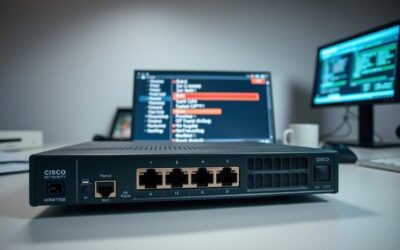In networking, the choice of topology can be very crucial in determining the overall performance and efficiency of the system. Among the most commonly used network topologies are the hub-and-spoke topology and full mesh topology. In this article, we’ll explore the pros and cons of each topology, the factors to consider when choosing a topology, the implementation process, and some case studies to help you make an informed decision when selecting a network topology for your organization.
Understanding Network Topology: A Brief Overview
A network topology refers to the layout or arrangement of various components of a network, including devices such as switches, routers, computers, and other peripherals. There are several types of network topologies, including bus, star, mesh, tree, and hybrid topologies. However, in this article, we’ll focus on the hub-and-spoke topology and full mesh topology.
The hub-and-spoke topology is a type of network topology where all devices are connected to a central hub, which acts as a central point of communication. This topology is commonly used in small to medium-sized networks, as it is easy to set up and manage. However, it can be a single point of failure, as if the hub fails, the entire network will be affected.
The full mesh topology, on the other hand, is a type of network topology where all devices are connected to each other. This topology is commonly used in large networks, as it provides high redundancy and fault tolerance. However, it can be expensive to implement and manage, as it requires a large number of connections and can be complex to troubleshoot in case of issues.
Advantages of Hub-and-Spoke Topology
One of the primary advantages of hub-and-spoke topology is that it’s easy to manage since it has fewer connections than full mesh topology. In a hub-and-spoke topology, all devices are connected to a central hub or switch, which acts as a traffic controller. This allows network administrators to monitor network activities easily and quickly detect and resolve issues.
Another advantage of the hub-and-spoke topology is that it’s relatively inexpensive to implement since it requires fewer connections. Additionally, it provides a dedicated communication channel between the hub and the spoke devices, which results in less network congestion and improved performance.
Furthermore, the hub-and-spoke topology is highly scalable, making it an ideal choice for organizations that anticipate future growth. New devices can be easily added to the network by connecting them to the central hub or switch, without the need to modify the existing connections. This makes it easy to expand the network as the organization grows, without incurring significant costs or causing disruptions to the existing network infrastructure.
Advantages of Full Mesh Topology
The full mesh topology provides a direct connection between every device in the network. This ensures high-speed data transfer and redundancy, making it ideal for critical applications that require 24/7 connectivity. With this topology, failure of one node doesn’t interrupt communication between other nodes, as there are alternative routes for the data to follow.
Moreover, the full mesh topology offers excellent scalability and flexibility, as more devices can be easily added without affecting the overall performance of the network. This topology is also ideal for organizations with heavy data traffic since it allows for parallel processing of data, reducing network congestion, and improving the overall efficiency of the network.
Another advantage of the full mesh topology is its high level of security. Since every device is connected to every other device, it is difficult for unauthorized users to access the network. Additionally, the full mesh topology allows for easy monitoring and management of the network, as each device can be individually accessed and controlled. This makes it easier to identify and troubleshoot any issues that may arise within the network.
Disadvantages of Hub-and-Spoke Topology
One of the disadvantages of the hub-and-spoke topology is that it relies heavily on the central hub. In the event of the hub’s failure or malfunction, communication between spokes would be impossible. Additionally, the dedicated communication channel between the hub and the spokes could lead to traffic congestion since all traffic must pass through the hub.
Another disadvantage of the hub-and-spoke topology is that it is not ideal for data-intensive applications since the central hub acts as a bottleneck, slowing down the overall network performance.
Furthermore, the hub-and-spoke topology may not be suitable for organizations that require high levels of security. Since all data passes through the central hub, it becomes a single point of failure and a potential target for cyber attacks. This makes it easier for hackers to intercept and access sensitive information, compromising the entire network.
Disadvantages of Full Mesh Topology
The primary disadvantage of full mesh topology is the high cost of implementation and maintenance. Since every device is connected to every other device, more cabling, networking hardware, and configuration are required to ensure proper functioning of the network. As such, full mesh topology is ideal for large organizations or those with a critical need for redundancy and high availability.
Moreover, the full mesh topology requires more bandwidth to enable parallel processing, which can cause more network traffic congestion in some cases.
Choosing the Right Network Topology for Your Business Needs
The choice of network topology depends on various factors, including the organization’s size, the volume of data traffic, the reliability required, and the budget allocated. Small organizations with fewer devices and less data traffic may opt for the hub-and-spoke topology because it’s inexpensive and easier to manage. However, large organizations that handle critical applications with high data traffic would benefit more from the full mesh topology.
Factors to Consider When Choosing a Network Topology
Several factors need to be considered when choosing a network topology, including the cost, the network’s size, the volume of data traffic, the reliability required, and existing infrastructure. A thorough analysis of these factors will help determine which topology is best suited for your organization.
Implementing Hub-and-Spoke Topology: Step-by-Step Guide
To implement the hub-and-spoke topology, follow these steps:
- Select a central hub or switch.
- Connect all the spokes to the hub.
- Configure the network and assign IP addresses to the devices.
- Test to ensure the network is working correctly.
Implementing Full Mesh Topology: Step-by-Step Guide
To implement the full mesh topology, follow these steps:
- Connect every device to every other device using cabling or wireless connectivity.
- Configure the network and assign IP addresses to the devices.
- Test to ensure the network is working correctly.
Comparing the Cost of Hub-and-Spoke vs Full Mesh Topology
The cost of implementing the hub-and-spoke topology is generally lower than that of full mesh topology since fewer connections are required. However, as the number of spokes increases, the cost of implementing the hub-and-spoke topology can quickly surpass that of full mesh topology.
Therefore, large organizations that require many connections are better off using the full mesh topology, while small businesses with fewer devices and less data traffic are better suited for the hub-and-spoke topology.
Scalability and Flexibility Comparison between Hub-and-Spoke and Full Mesh Topologies
The full mesh topology is more flexible and scalable than the hub-and-spoke topology since it allows for parallel data processing. As more devices are added to the network, the full mesh topology is better suited for handling the increased traffic.
The hub-and-spoke topology falls short in this regard since all traffic must pass through the central hub, which can lead to congestion as more devices are added to the network.
Security Comparison between Hub-and-Spoke and Full Mesh Topologies
The hub-and-spoke topology is generally considered more secure than the full mesh topology since all traffic flows through a central hub. This allows for easy tracking and monitoring of network traffic, reducing the risk of unauthorized access or data breaches.
The full mesh topology is less secure since each device is directly connected to every other device, making it difficult to track and monitor traffic. This increases the risk of unauthorized access or data breaches.
Performance Comparison between Hub-and-Spoke and Full Mesh Topologies
The full mesh topology offers better performance than the hub-and-spoke topology since all devices are directly connected, allowing for parallel data processing and redundancy. This topology is ideal for high-intensity applications that require 24/7 connectivity and no downtime.
The hub-and-spoke topology has lower performance than the full mesh topology since all traffic must pass through the central hub, which can cause traffic congestion and slow down the overall network performance.
Case Studies: Companies that Use Hub-and-Spoke vs Full Mesh Topology
Many large organizations use either hub-and-spoke or full mesh topology, depending on their network requirements. For example, NASA uses a full mesh topology for their communication network due to its scalability, redundancy, and high performance. On the other hand, Walmart uses a hub-and-spoke topology because it’s less expensive to implement and easier to manage.
Future Trends in Network Topologies: Is There a Better Alternative to These Two?
While the hub-and-spoke topology and full mesh topology have been the standard for many years, new network topologies are emerging, such as the hybrid topology, which combines the benefits of both topologies. This allows organizations to achieve the redundancy and high performance of full mesh topology while maintaining the cost-effectiveness and simplicity of the hub-and-spoke topology.
In conclusion, the choice of network topology depends on several factors. Hub-and-spoke topology is ideal for small organizations with fewer devices and less data traffic, while full mesh topology is preferred for large organizations with high data traffic and critical applications. Still, hybrid topologies may provide the best of both worlds for organizations that require redundancy, performance, and cost-effectiveness.
Notes on Hub and Spoke Vs Mesh
Network devices:
- Network devices are hardware components that are used to connect computers, servers, and other devices to a network. They include routers, switches, modems, and wireless access points.
- Routers are network devices that direct data traffic between different networks, ensuring that information is sent to the correct destination. They use IP addresses to determine the most efficient path for data transmission.
- Switches are network devices that connect multiple devices within a local area network (LAN). They use MAC addresses to direct data packets to the appropriate device, improving network efficiency and reducing congestion.
Network connections:
- Network congestion occurs when there is a high demand for network connections, resulting in slower data transfer speeds and increased latency. This can happen when too many devices are trying to access the network at the same time, overwhelming the available bandwidth.
- To alleviate network congestion, network administrators can implement traffic shaping techniques to prioritize certain types of network traffic over others. This helps ensure that critical applications and services receive the necessary bandwidth while less important traffic is given lower priority.
- In addition to traffic shaping, network congestion can also be managed through the use of quality of service (QoS) protocols. QoS allows network administrators to assign different levels of priority to different types of network traffic, ensuring that time-sensitive applications, such as voice and video calls, are given higher priority over less time-sensitive traffic like file downloads.
Network administrators:
- Network administrators are responsible for managing and maintaining computer networks within an organization. They are in charge of setting up and configuring network devices such as routers, switches, and firewalls to ensure smooth and secure data transmission.
- Network administrators monitor network performance, troubleshoot issues, and implement necessary upgrades or repairs to keep the network running efficiently. They also play a crucial role in ensuring network security by implementing and managing firewalls, intrusion detection systems, and other security measures.
- In addition to technical skills, network administrators need strong problem-solving and communication skills to effectively collaborate with other IT professionals and provide support to end-users. They are often required to stay updated with the latest advancements in networking technology to ensure the network infrastructure remains up-to-date and optimized.
Network requirements:
- Network requirements refer to the specific criteria and conditions that must be met in order for a network to function optimally. These requirements can include factors such as bandwidth, latency, security, and scalability.
- One important aspect of network requirements is bandwidth, which refers to the amount of data that can be transmitted over a network in a given amount of time. Higher bandwidth is typically required for tasks that involve large file transfers or streaming media.
- Another crucial network requirement is security. This involves implementing measures such as firewalls, encryption, and access controls to protect sensitive data and prevent unauthorized access to the network.
Network topology alternatives:
- Network topology refers to the layout or arrangement of the various elements of a computer network. There are several alternatives to choose from, depending on the specific needs and requirements of the network.
- One alternative is the star topology, where all devices are connected to a central hub or switch. This type of topology offers high reliability and ease of troubleshooting, as any issues with one device do not affect the rest of the network.
- Another alternative is the mesh topology, where every device is connected to every other device in the network. This type of topology provides redundancy and fault tolerance, as multiple paths are available for data transmission. However, it can be costly to implement and maintain.
Network failure:
- Network failure refers to a situation where a computer network is unable to perform its intended functions due to various reasons such as hardware or software issues, power outages, or network congestion.
- Network failures can have significant consequences for businesses, causing disruptions in communication, data loss, and decreased productivity. It is crucial for organizations to have robust network monitoring and backup systems in place to minimize the impact of network failures.
- Preventing network failures requires proactive measures such as regular network maintenance, ensuring sufficient network capacity, and implementing redundancy in network infrastructure to provide backup options in case of failures.
Network downtime:
- Network downtime refers to the period of time when a network or a specific network service is unavailable or not functioning properly. This can be caused by various factors such as hardware or software failures, power outages, or network congestion.
- Network downtime can have significant impacts on businesses and organizations, leading to loss of productivity, revenue, and customer satisfaction. It can disrupt communication, data transfer, and access to critical resources, affecting daily operations and causing financial losses.
- To minimize network downtime, organizations often implement redundancy and failover mechanisms, such as backup power supplies, redundant network devices, and diverse network paths. Regular network maintenance, monitoring, and proactive troubleshooting are also essential to identify and resolve potential issues before they cause extended periods of downtime.
Network applications:
- Network applications are software programs that utilize a network connection to perform specific tasks, such as sending and receiving data, sharing resources, or communicating with other devices.
- These applications can be both client-based, where they run on individual devices and interact with a server, or web-based, where they are accessed through a web browser and run on remote servers.
- Examples of network applications include email clients, web browsers, video conferencing software, file sharing programs, and online gaming platforms.
Network data transmission:
- Network data transmission refers to the process of sending and receiving data over a network, such as the internet or a local area network (LAN).
- It involves the transfer of digital information from one device to another, using various protocols and technologies to ensure reliable and efficient communication.
- Network data transmission plays a crucial role in enabling the exchange of information between devices, allowing users to access and share data across different platforms and locations.
Network architecture:
- Network architecture refers to the design and layout of a computer network, including its hardware and software components. It determines how data is transmitted, received, and processed within the network.
- A well-designed network architecture is crucial for ensuring efficient and reliable communication between devices. It involves decisions on factors such as network topology, protocols, and security measures.
- Network architecture plays a vital role in supporting various network applications, such as file sharing, email communication, and web browsing. It provides the framework for these applications to function seamlessly and securely.
Network nodes:
- Network nodes are devices or points in a network where data can be transmitted, received, or processed.
- These nodes can be physical devices such as computers, routers, switches, or servers, or they can be virtual entities such as virtual machines or software applications.
- Each network node has a unique address or identifier, which allows it to communicate with other nodes and participate in data transmission and routing within the network.
Network links:
- Network links are connections between different devices or systems that allow them to communicate and share information with each other.
- These links can be physical, such as Ethernet cables or wireless connections, or they can be virtual, such as VPN tunnels or internet connections.
- Network links play a crucial role in the functioning of a network, as they enable the transfer of data and ensure that devices can communicate effectively.
Network protocols:
- Network protocols are a set of rules and guidelines that govern the communication between devices in a network. They define how data is transmitted, received, and interpreted, ensuring that devices can understand and interact with each other.
- There are various types of network protocols, such as TCP/IP (Transmission Control Protocol/Internet Protocol), which is the foundation of the internet, and HTTP (Hypertext Transfer Protocol), which is used for web browsing. Each protocol has its own specific purpose and functionality.
- Network protocols play a crucial role in ensuring the reliability, security, and efficiency of network communications. They enable devices to establish connections, exchange data, and maintain the integrity of the transmitted information.
Network standards:
- Network standards refer to the guidelines and protocols that define how devices and systems communicate and interact with each other in a network. These standards ensure compatibility and interoperability between different devices and networks.
- One of the most well-known network standards is the Ethernet standard, which defines the physical and data link layer specifications for wired local area networks (LANs). Ethernet has evolved over the years, with different variants such as Fast Ethernet and Gigabit Ethernet, to provide faster and more reliable network connections.
- Another important network standard is the Internet Protocol (IP), which is a set of rules that governs how data is sent and received over the internet. IP enables devices to be uniquely identified and allows for the routing of data packets between different networks.
Network services:
- Network services refer to the various protocols and tools that enable communication and data transfer between devices on a network.
- These services include functions such as file sharing, remote access, email services, and network printing, which are essential for efficient collaboration and information exchange within an organization.
- Common network service protocols include TCP/IP, DNS, DHCP, FTP, and SNMP, each serving a specific purpose in facilitating network connectivity and data transmission.
Network limitations:
- Network limitations refer to the constraints or restrictions that can affect the performance or functionality of a computer network.
- One common network limitation is bandwidth, which refers to the amount of data that can be transmitted over a network connection in a given amount of time. Limited bandwidth can result in slow network speeds and decreased performance.
- Another network limitation is latency, which is the amount of time it takes for data to travel from one point to another on a network. High latency can cause delays and lag in network communication.
Network configurations:
- Network configurations refer to the settings and arrangements that determine how devices and systems on a network communicate with each other. These configurations include IP addresses, subnet masks, default gateways, DNS settings, and more.
- Proper network configurations are essential for ensuring smooth and efficient communication between devices and systems. They help prevent network congestion, improve network security, and optimize network performance.
- Network configurations can be manually set by network administrators or automatically assigned through protocols like DHCP (Dynamic Host Configuration Protocol). It is important to regularly review and update network configurations to adapt to changing network requirements and address any issues that may arise.
Network limitations:
- Network limitations refer to the restrictions or constraints that may be imposed on a network, preventing it from functioning optimally or accessing certain resources. These limitations can be caused by factors such as bandwidth limitations, network congestion, or security measures.
- Bandwidth limitations are a common type of network limitation that can occur when there is not enough available bandwidth to support the amount of data being transmitted. This can result in slow network speeds or dropped connections, particularly during periods of high network usage.
- Network congestion is another network limitation that can occur when there is a high volume of traffic on a network, causing delays in data transmission and potentially impacting the performance of connected devices. Network congestion can be managed through techniques such as traffic shaping or prioritization.
Network configurations:
- Network configurations refer to the process of setting up and organizing the different components of a network, such as routers, switches, and firewalls, to ensure optimal performance and security.
- By properly configuring a network, businesses can control how data flows between devices, allocate bandwidth to different applications, and implement security measures to protect against unauthorized access or data breaches.
- Network configurations can vary depending on the specific needs of an organization, such as the number of users, the types of devices connected, and the desired level of security. It is important to regularly review and update network configurations to adapt to changing technologies and threats.





